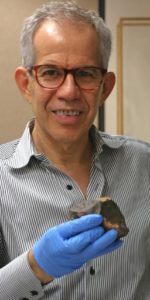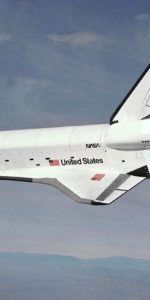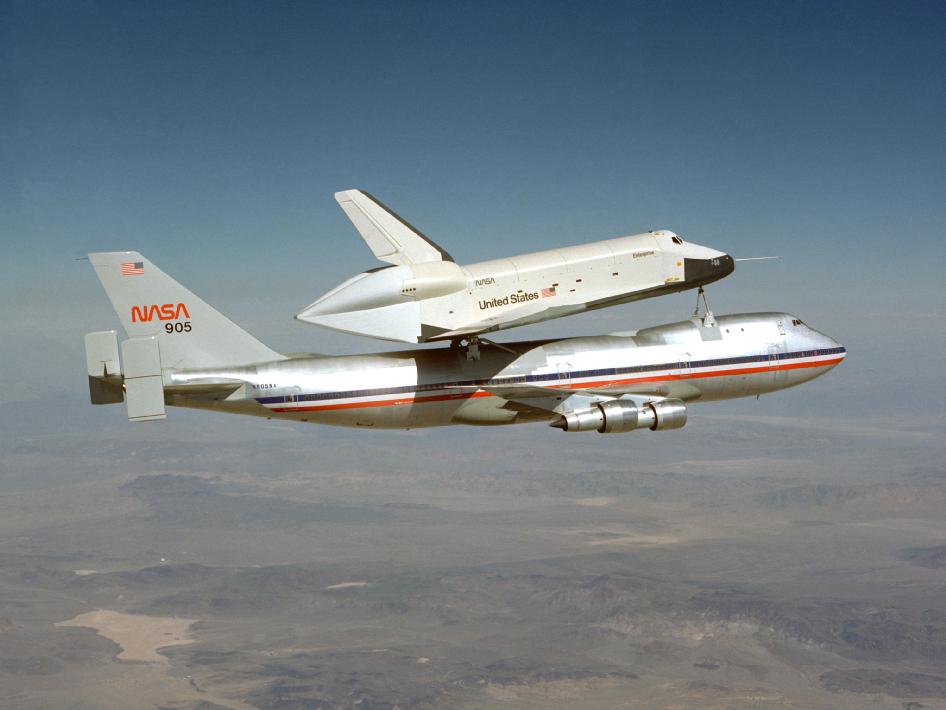
When we think of the space shuttle, we think of the five spaceworthy orbiter vehicles—Columbia, Challenger, Discovery, Atlantis, and Endeavour—which carved an indelible mark on the United States’ fortunes in low-Earth orbit for no less than three decades. Between the maiden liftoff of Columbia on STS-1 in April 1981 and the final touchdown of Atlantis at the close of STS-135 in July 2011, men and women deployed, retrieved, and repaired commercial and scientific satellites, launched classified Department of Defense assets, visited Russia’s Mir space station, and labored to assemble the most complex engineering feat in human history: the International Space Station (ISS). Yet without the contribution of the often-unsung Orbiter Vehicle (OV)-101, Enterprise, the intricacies of how the shuttle would one day perform during its descent through the low atmosphere to landing would have been infinitely more difficult to understand.
Although Enterprise never flew in space, her contribution removed much of NASA’s uncertainty in the mid-1970s about the handling characteristics of this new, delta-winged space vehicle. Her construction was completed in March 1976 and the following 17 September—40 years ago, last month—she was rolled out to begin final preparations for a series of Approach and Landing Tests (ALTs) over Edwards Air Force Base, Calif.
Enterprise’s name has become the stuff of space program legend. Original plans, dating to July 1972, when NASA contracted with North American Rockwell to build a pair of Earth-orbiting shuttles: one named “Constitution” (OV-101) and the other “Columbia” (OV-102). The former would support the ALT series, before being upgraded for orbital missions, whilst Columbia would kick off a space career on her very first flight. However, a mass influx of over 100,000 letters to then-President Gerald Ford from Star Trek fans prompted NASA to rename Constitution as “Enterprise.” The space agency reportedly did not approve of the new name, preferring to honor the forthcoming 1977 bicentennial of the U.S. Declaration of Independence. But when Enterprise rolled out of Rockwell’s Air Force Plant 42 at Palmdale, Calif., on 17 September 1976, the fans’ wish was visibly granted.
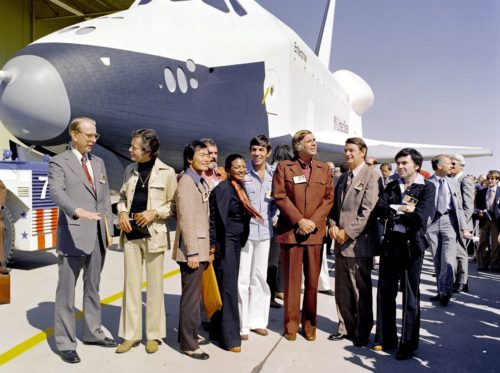
Following her rollout, in January 1977 she was towed 35 miles (58 km) overland to Edwards in readiness for her ALT duties. A few weeks later, she was hoisted atop the Boeing 747 Shuttle Carrier Aircraft (SCA), via the Mate-Demate Device (MDD), for a trio of taxi tests along the runway. The modified 747 had been purchased by NASA from American Airlines in June 1974, partly because it was the largest available aircraft to handle the DC-3-sized shuttle orbiter. Yet it still required the removal of almost all of its internal equipment, as well as major modifications to its wiring, plumbing, and air-conditioning and the installation of higher-thrust engines. Internal supports were fitted to its upper fuselage and, following wind tunnel testing, endplate-style vertical stabilizers were mounted on its horizontal tail. The 747 undertook a maiden flight in this configuration in December 1976.
The three taxi flights occurred in the early morning, in order to reduce heating on the 747’s tires and brakes. In addition to the 400,000-pound (180,000-kg) load of the aircraft itself, there was the 150,000 pounds (68,000 kg) of Enterprise herself, and several speeds were trialed along the runway, from 88 mph (143 km/h) to 140 mph (225 km/h) and finally 155 mph (250 km/h). From late February until early March 1977, the 747 crew of pilots Fitz Fulton and Tom McMurtry and flight engineers Vic Horton and Louis “Skip” Guidry executed five airborne runs with the unmanned Enterprise to assess their structural integrity and handling characteristics at altitude. In post-flight remarks, both Fulton and McMurtry noted that the presence of Enterprise atop their aircraft had little adverse effect on their ability to maintain control. This was partly due to the presence of a large aerodynamic tail cone on the shuttle’s aft fuselage.
Additional “lift” was afforded by Enterprise’s delta-shaped wings and several aerospace journalists later quipped that they had seen the debut of the world’s largest biplane. During these so-called “captive-inert” flights, Fulton and McMurtry performed a “short-field” landing and demonstrated the capability to slow the 747/shuttle combo to a complete halt in less than 6,000 feet (1,800 meters). With the captive-inert flights finished by the first week of March 1977, the time had come to modify Enterprise for her first crew. Three “captive-active” tests were planned for June-July, in which the shuttle would remain affixed to the 747, followed by up to eight “free flights” from August onward, in which she would separate from the aircraft and glide to an unpowered landing at Edwards.
Flying Enterprise for the first time were Commander Fred Haise—a veteran of the ill-fated Apollo 13 mission—and Pilot Gordon Fullerton. Haise had been assigned to shuttle development duties since April 1973 and from February 1976 had led the ALT Program. Joining him on the program were Fullerton and fellow astronauts Joe Engle and Dick Truly. “The initial Approach and Landing Tests on the orbiter were, in fact, just that,” recalled Engle in a May 2004 oral history for NASA, “and that was to place the vehicle in aerodynamic flight by itself and exercise all of the systems that we could: hydraulic systems, electronic systems, the flight control systems and landing gear, in a real flight environment, and to gather as much as flight test information as far as stability and control parameters and performance parameters and do it partly in an ideal environment. In other words, not have to worry about coming in to land and the wind coming up and giving you a big cross wind, or low clouds or things like that. You could take off and an hour later, drop, and you knew what the weather was going to be. Of course, at Edwards, it was normally pretty good anyway. But you could set yourself up ideally over the lakebed, too, so you didn’t have the navigation concerns that you do coming back from orbit.
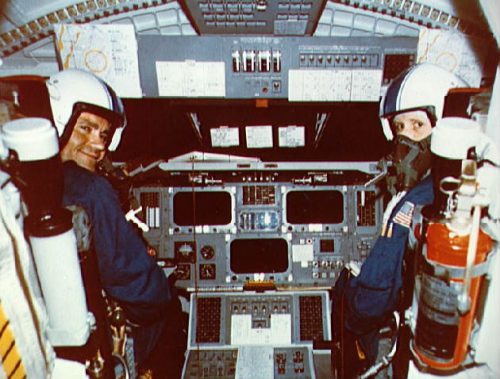
“The Approach and Landing Tests [were] initially designed for about 11 flights and as we flew more flights, there was indeed pressure from the other end to hurry up and finish, so that those engineers could be assigned to the orbital flight test vehicle and the orbital flight looked like it was going to take resources and shorten up the initial approach and landing tests. The approach and landing tests were going very efficiently, too, so we were getting a lot of data and were able to condense the program from 11 flights down to what ended up to be five.”
All four astronauts were intimately involved in the design and development of ALT software and flight procedures. “People say How do you train?” remembered Gordon Fullerton, “thinking, ‘Well, you go to a school and somebody tells you how to do it’. It’s not like that at all. Somebody’s got to write the checklist, so you end up writing the checklist, working with each subsystems person and trying to come up with a pre-launch checklist for the Approach and Landing Tests. So you’re doing the work [and] the learning comes from doing jobs that needed to be done. We worried about doing this deadstick landing, so we had to train for that. I built a gadget to work on the T-38 [training jets] that would allow you with any given weight to set the power with the speedbrakes down to simulate what the data said the orbiter would fly it at, so that we could go fly the pattern we intended to fly in T-38s, making steep descents, flaring and touching down.”
At length, on the morning of 17 June 1977, all was ready. Clad in bulky pressure suits, Haise and Fullerton awoke to a cool dawn in the Edwards desert to take the first space shuttle on its first operational spin in the atmosphere.
The second part of this article will appear tomorrow.
Want to keep up-to-date with all things space? Be sure to “Like” AmericaSpace on Facebook and follow us on Twitter: @AmericaSpace




